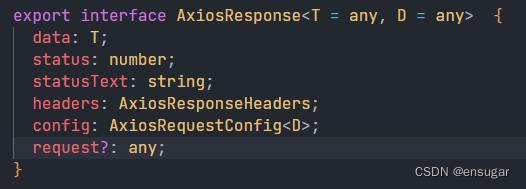使用TS对axios的进行简单封装
Posted enwinter
tags:
篇首语:本文由小常识网(cha138.com)小编为大家整理,主要介绍了使用TS对axios的进行简单封装相关的知识,希望对你有一定的参考价值。
1.安装axios
npm i axios
2.在合适路径下新建request.ts(名称可随意),例如可以在项目的src下创建utils文件夹创建request.ts

3.导入axios并创建axios实例
//引入axios
import axios from 'axios'
//使用指定配置创建axios实例
const instance = axios.create(
// 基础路径
baseURL: 'http://pcapi-xiaotuxian-front-devtest.itheima.net/',
// 请求超时时间
timeout: 5000,
// ....其他配置
)
4.封装请求函数
① 查看axios的类型声明文件

② 请求配置对象的类型

从图中可知AxiosRequestConfig是axios请求配置对象的接口,例如下面的代码,axios函数的第一个参数就是AxiosRequestConfig接口的实例。而泛型D则是请求配置对象(axios函数的第一个参数)中data的类型,默认类型为any,因为AxiosRequestConfig接口内容太多就不列出来了。
axios(
url: 'http://',
method: 'post',
data:
// ....
)
③ 响应对象的类型

axios发送数据请求后会返回的promise实例,AxiosResponse就是这个promise实例成功后回调函数的第一个参数的类型,例如下面的代码,代码中的response的类型就是AxiosResponse。
axios(
url: 'http://',
method: 'post',
data:
).then((response) =>
console.log(response.data)
)
从下图可知,AxiosResponse接口第一个泛型参数T,泛型T就是AxiosResponse接口中data的数据类型,默认类型为any,也就是上图response.data的类型。第二个泛型参数和请求配置对象一样,是AxiosRequestConfig接口中data的类型,默认类型为any。

④ axios.request函数
从axios的声明文件中可以看出直接使用axios()发送网络请求是不能指定泛型参数的,而axios.request()对泛型的支持非常友好,请看下图

request函数的第一个泛型T指定了第二个泛型AxiosResponse接口中data的类型。第二个泛型R默认为AxiosResponse,指定了request函数返回的promise实例成功的回调函数的第一个参数的类型。第三个泛型D指定了请求配置对象中data的数据类型。(看不懂的话,请再结合第②③点再看一次)
⑤ 开始封装
// 后台给我们的数据类型如下
// 泛型T指定了Response类型中result的类型,默认为any
type Response<T = any> =
// 描述
msg: string
// 返回的数据
result: T
// AxiosRequestConfig从axios中导出的,将config声明为AxiosRequestConfig,这样我们调用函数时就可以获得TS带来的类型提示
// 泛型T用来指定Reponse类型中result的类型
export default <T> (config: AxiosRequestConfig) =>
// 指定promise实例成功之后的回调函数的第一个参数的类型为Response<T>
return new Promise<Response<T>>((resolve, reject) =>
// instance是我们在上面创建的axios的实例
// 我们指定instance.request函数的第一个泛型为Response,并把Response的泛型指定为函数的泛型T
// 第二个泛型AxiosResponse的data类型就被自动指定为Response<T>
// AxiosResponse从axios中导出的,也可以不指定,TS会自动类型推断
instance.request<Response<T>>(config).then((response: AxiosResponse<Response<T>>) =>
// response类型就是AxiosResponse<Response<T>>,而data类型就是我们指定的Response<T>
// 请求成功后就我们的数据从response取出并使返回的promise实例的状态变为成功的
resolve(response.data)
).catch((error :any) =>
// 请求失败的处理
reject(error)
)
)
⑥ 使用
import request from "@/utils/request";
// 商品分类
export interface Category
id: string;
name: string;
picture: string;
children: Category[];
goods: CategoryGoods[];
// 商品分类下的商品
export interface CategoryGoods
id: string;
name: string;
desc: string;
price: string;
picture: string;
/**
* 获取首页商品分类
* @returns 首页商品分类数组
*/
export const reqGetCategory = () =>
// 指定我们封装的request函数的第一个泛型的类型为Category[],也就是指定 Response<T> 中T的类型
return request<Category[]>(
url: '/home/category/head',
method: 'get'
)
这样我就可以得到类型提示了
下图resonse的类型是Response

下图response.result的类型是Category[]

下图是response.result数组中元素的类型是Category

从下图我们可以看出response的类型

还可以在拦截器里添加更多功能,这里就不再赘述了。如有错误,请多包涵。
在项目中用TS封装axios,一次封装团队受益
作者:一碗周
原文:https://juejin.cn/post/7071518211392405541
写在前面
虽然说Fetch API已经使用率已经非常的高了,但是在一些老的浏览器还是不支持的,而且axios仍然每周都保持2000多万的下载量,这就说明了axios仍然存在不可撼动的地位,接下来我们就一步一步的去封装,实现一个灵活、可复用的一个请求请发。
这篇文章封装的axios已经满足如下功能:
无处不在的代码提示;
灵活的拦截器;
可以创建多个实例,灵活根据项目进行调整;
每个实例,或者说每个接口都可以灵活配置请求头、超时时间等;
取消请求(可以根据url取消单个请求也可以取消全部请求)。
基础封装
首先我们实现一个最基本的版本,实例代码如下:
// index.ts
import axios from 'axios'
import type AxiosInstance, AxiosRequestConfig from 'axios'
class Request
// axios 实例
instance: AxiosInstance
constructor(config: AxiosRequestConfig)
this.instance = axios.create(config)
request(config: AxiosRequestConfig)
return this.instance.request(config)
export default Request这里将其封装为一个类,而不是一个函数的原因是因为类可以创建多个实例,适用范围更广,封装性更强一些。
拦截器封装
首先我们封装一下拦截器,这个拦截器分为三种:
类拦截器
实例拦截器
接口拦截器
接下来我们就分别实现这三个拦截器。
类拦截器
类拦截器比较容易实现,只需要在类中对axios.create()创建的实例调用interceptors下的两个拦截器即可,实例代码如下:
// index.ts
constructor(config: AxiosRequestConfig)
this.instance = axios.create(config)
this.instance.interceptors.request.use(
(res: AxiosRequestConfig) =>
console.log('全局请求拦截器')
return res
,
(err: any) => err,
)
this.instance.interceptors.response.use(
// 因为我们接口的数据都在res.data下,所以我们直接返回res.data
(res: AxiosResponse) =>
console.log('全局响应拦截器')
return res.data
,
(err: any) => err,
)
我们在这里对响应拦截器做了一个简单的处理,就是将请求结果中的.data进行返回,因为我们对接口请求的数据主要是存在在.data中,跟data同级的属性我们基本是不需要的。
实例拦截器
实例拦截器是为了保证封装的灵活性,因为每一个实例中的拦截后处理的操作可能是不一样的,所以在定义实例时,允许我们传入拦截器。
首先我们定义一下interface,方便类型提示,代码如下:
// types.ts
import type AxiosRequestConfig, AxiosResponse from 'axios'
export interface RequestInterceptors
// 请求拦截
requestInterceptors?: (config: AxiosRequestConfig) => AxiosRequestConfig
requestInterceptorsCatch?: (err: any) => any
// 响应拦截
responseInterceptors?: (config: AxiosResponse) => AxiosResponse
responseInterceptorsCatch?: (err: any) => any
// 自定义传入的参数
export interface RequestConfig extends AxiosRequestConfig
interceptors?: RequestInterceptors
定义好基础的拦截器后,我们需要改造我们传入的参数的类型,因为axios提供的AxiosRequestConfig是不允许我们传入拦截器的,所以说我们自定义了RequestConfig,让其继承与AxiosRequestConfig 。
剩余部分的代码也比较简单,如下所示:
// index.ts
import axios, AxiosResponse from 'axios'
import type AxiosInstance, AxiosRequestConfig from 'axios'
import type RequestConfig, RequestInterceptors from './types'
class Request
// axios 实例
instance: AxiosInstance
// 拦截器对象
interceptorsObj?: RequestInterceptors
constructor(config: RequestConfig)
this.instance = axios.create(config)
this.interceptorsObj = config.interceptors
this.instance.interceptors.request.use(
(res: AxiosRequestConfig) =>
console.log('全局请求拦截器')
return res
,
(err: any) => err,
)
// 使用实例拦截器
this.instance.interceptors.request.use(
this.interceptorsObj?.requestInterceptors,
this.interceptorsObj?.requestInterceptorsCatch,
)
this.instance.interceptors.response.use(
this.interceptorsObj?.responseInterceptors,
this.interceptorsObj?.responseInterceptorsCatch,
)
// 全局响应拦截器保证最后执行
this.instance.interceptors.response.use(
// 因为我们接口的数据都在res.data下,所以我们直接返回res.data
(res: AxiosResponse) =>
console.log('全局响应拦截器')
return res.data
,
(err: any) => err,
)
我们的拦截器的执行顺序为实例请求→类请求→实例响应→类响应;这样我们就可以在实例拦截上做出一些不同的拦截,
接口拦截
现在我们对单一接口进行拦截操作,首先我们将AxiosRequestConfig类型修改为RequestConfig允许传递拦截器;然后我们在类拦截器中将接口请求的数据进行了返回,也就是说在request()方法中得到的类型就不是AxiosResponse类型了。
我们查看axios的index.d.ts中,对request()方法的类型定义如下:
// type.ts
request<T = any, R = AxiosResponse<T>, D = any>(config: AxiosRequestConfig<D>): Promise<R>;也就是说它允许我们传递类型,从而改变request()方法的返回值类型,我们的代码如下:
// index.ts
request<T>(config: RequestConfig): Promise<T>
return new Promise((resolve, reject) =>
// 如果我们为单个请求设置拦截器,这里使用单个请求的拦截器
if (config.interceptors?.requestInterceptors)
config = config.interceptors.requestInterceptors(config)
this.instance
.request<any, T>(config)
.then(res =>
// 如果我们为单个响应设置拦截器,这里使用单个响应的拦截器
if (config.interceptors?.responseInterceptors)
res = config.interceptors.responseInterceptors<T>(res)
resolve(res)
)
.catch((err: any) =>
reject(err)
)
)
这里还存在一个细节,就是我们在拦截器接受的类型一直是AxiosResponse类型,而在类拦截器中已经将返回的类型改变,所以说我们需要为拦截器传递一个泛型,从而使用这种变化,修改types.ts中的代码,示例如下:
// index.ts
export interface RequestInterceptors
// 请求拦截
requestInterceptors?: (config: AxiosRequestConfig) => AxiosRequestConfig
requestInterceptorsCatch?: (err: any) => any
// 响应拦截
responseInterceptors?: <T = AxiosResponse>(config: T) => T
responseInterceptorsCatch?: (err: any) => any
请求接口拦截是最前执行,而响应拦截是最后执行。
封装请求方法
现在我们就来封装一个请求方法,首先是类进行实例化示例代码如下:
// index.ts
import Request from './request'
const request = new Request(
baseURL: import.meta.env.BASE_URL,
timeout: 1000 * 60 * 5,
interceptors:
// 请求拦截器
requestInterceptors: config =>
console.log('实例请求拦截器')
return config
,
// 响应拦截器
responseInterceptors: result =>
console.log('实例响应拦截器')
return result
,
,
)然后我们封装一个请求方法, 来发送网络请求,代码如下:
// src/server/index.ts
import Request from './request'
import type RequestConfig from './request/types'
interface YWZRequestConfig<T> extends RequestConfig
data?: T
interface YWZResponse<T>
code: number
message: string
data: T
/**
* @description: 函数的描述
* @interface D 请求参数的interface
* @interface T 响应结构的intercept
* @param YWZRequestConfig config 不管是GET还是POST请求都使用data
* @returns Promise
*/
const ywzRequest = <D, T = any>(config: YWZRequestConfig<D>) =>
const method = 'GET' = config
if (method === 'get' || method === 'GET')
config.params = config.data
return request.request<YWZResponse<T>>(config)
export default ywzRequest该请求方式默认为GET,且一直用data作为参数;
取消请求
应评论区@Pic、@Michaelee和@Alone_Error的建议,这里增加了一个取消请求;关于什么是取消请求可以参考官方文档[1]。
准备工作
我们需要将所有请求的取消方法保存到一个集合(这里我用的数组,也可以使用Map)中,然后根据具体需要去调用这个集合中的某个取消请求方法。
首先定义两个集合,示例代码如下:
// index.ts
import type
RequestConfig,
RequestInterceptors,
CancelRequestSource,
from './types'
class Request
/*
存放取消方法的集合
* 在创建请求后将取消请求方法 push 到该集合中
* 封装一个方法,可以取消请求,传入 url: string|string[]
* 在请求之前判断同一URL是否存在,如果存在就取消请求
*/
cancelRequestSourceList?: CancelRequestSource[]
/*
存放所有请求URL的集合
* 请求之前需要将url push到该集合中
* 请求完毕后将url从集合中删除
* 添加在发送请求之前完成,删除在响应之后删除
*/
requestUrlList?: string[]
constructor(config: RequestConfig)
// 数据初始化
this.requestUrlList = []
this.cancelRequestSourceList = []
这里用的CancelRequestSource接口,我们去定义一下:
// type.ts
export interface CancelRequestSource
[index: string]: () => void
这里的key是不固定的,因为我们使用url做key,只有在使用的时候才知道url,所以这里使用这种语法。
取消请求方法的添加与删除
首先我们改造一下request()方法,它需要完成两个工作,一个就是在请求之前将url和取消请求方法push到我们前面定义的两个属性中,然后在请求完毕后(不管是失败还是成功)都将其进行删除,实现代码如下:
// index.ts
request<T>(config: RequestConfig): Promise<T>
return new Promise((resolve, reject) =>
// 如果我们为单个请求设置拦截器,这里使用单个请求的拦截器
if (config.interceptors?.requestInterceptors)
config = config.interceptors.requestInterceptors(config)
const url = config.url
// url存在保存取消请求方法和当前请求url
if (url)
this.requestUrlList?.push(url)
config.cancelToken = new axios.CancelToken(c =>
this.cancelRequestSourceList?.push(
[url]: c,
)
)
this.instance
.request<any, T>(config)
.then(res =>
// 如果我们为单个响应设置拦截器,这里使用单个响应的拦截器
if (config.interceptors?.responseInterceptors)
res = config.interceptors.responseInterceptors<T>(res)
resolve(res)
)
.catch((err: any) =>
reject(err)
)
.finally(() =>
url && this.delUrl(url)
)
)
这里我们将删除操作进行了抽离,将其封装为一个私有方法,示例代码如下:
// index.ts
/**
* @description: 获取指定 url 在 cancelRequestSourceList 中的索引
* @param string url
* @returns number 索引位置
*/
private getSourceIndex(url: string): number
return this.cancelRequestSourceList?.findIndex(
(item: CancelRequestSource) =>
return Object.keys(item)[0] === url
,
) as number
/**
* @description: 删除 requestUrlList 和 cancelRequestSourceList
* @param string url
* @returns *
*/
private delUrl(url: string)
const urlIndex = this.requestUrlList?.findIndex(u => u === url)
const sourceIndex = this.getSourceIndex(url)
// 删除url和cancel方法
urlIndex !== -1 && this.requestUrlList?.splice(urlIndex as number, 1)
sourceIndex !== -1 &&
this.cancelRequestSourceList?.splice(sourceIndex as number, 1)
取消请求方法
现在我们就可以封装取消请求和取消全部请求了,我们先来封装一下取消全部请求吧,这个比较简单,只需要调用this.cancelRequestSourceList中的所有方法即可,实现代码如下:
// index.ts
// 取消全部请求
cancelAllRequest()
this.cancelRequestSourceList?.forEach(source =>
const key = Object.keys(source)[0]
source[key]( "key")
)
现在我们封装一下取消请求,因为它可以取消一个和多个,那它的参数就是url,或者包含多个URL的数组,然后根据传值的不同去执行不同的操作,实现代码如下:
// index.ts
// 取消请求
cancelRequest(url: string | string[])
if (typeof url === 'string')
// 取消单个请求
const sourceIndex = this.getSourceIndex(url)
sourceIndex >= 0 && this.cancelRequestSourceList?.[sourceIndex][url]( "sourceIndex][url")
else
// 存在多个需要取消请求的地址
url.forEach(u =>
const sourceIndex = this.getSourceIndex(u)
sourceIndex >= 0 && this.cancelRequestSourceList?.[sourceIndex][u]( "sourceIndex][u")
)
测试
测试请求方法
现在我们就来测试一下这个请求方法,这里我们使用www.apishop.net/[2]提供的免费API进行测试,测试代码如下:
<script setup lang="ts">
// app.vue
import request from './service'
import onMounted from 'vue'
interface Req
apiKey: string
area?: string
areaID?: string
interface Res
area: string
areaCode: string
areaid: string
dayList: any[]
const get15DaysWeatherByArea = (data: Req) =>
return request<Req, Res>(
url: '/api/common/weather/get15DaysWeatherByArea',
method: 'GET',
data,
interceptors:
requestInterceptors(res)
console.log('接口请求拦截')
return res
,
responseInterceptors(result)
console.log('接口响应拦截')
return result
,
,
)
onMounted(async () =>
const res = await get15DaysWeatherByArea(
apiKey: import.meta.env.VITE_APP_KEY,
area: '北京市',
)
console.log(res.result.dayList)
)
</script>如果在实际开发中可以将这些代码分别抽离。
上面的代码在命令中输出
接口请求拦截
实例请求拦截器
全局请求拦截器
实例响应拦截器
全局响应拦截器
接口响应拦截
[…, …, …, …, …, …, …, …, …, …, …, …, …, …, …]测试取消请求
首先我们在.server/index.ts中对取消请求方法进行导出,实现代码如下:
// 取消请求
export const cancelRequest = (url: string | string[]) =>
return request.cancelRequest(url)
// 取消全部请求
export const cancelAllRequest = () =>
return request.cancelAllRequest()
然后我们在app.vue中对其进行引用,实现代码如下:
<template>
<el-button
@click="cancelRequest('/api/common/weather/get15DaysWeatherByArea')"
>取消请求</el-button
>
<el-button @click="cancelAllRequest">取消全部请求</el-button>
<router-view></router-view>
</template>
<script setup lang="ts">
import request, cancelRequest, cancelAllRequest from './service'
</script>发送请求后,点击按钮即可实现对应的功能
写在最后
本篇文章到这里就结束了,如果文章对你有用,可以三连支持一下,如果文章中有错误或者说你有更好的见解,欢迎指正~
项目地址:ywanzhou/vue3-template (github.com)[3]
参考资料
[1]
官方文档: https://axios-http.com/docs/cancellation
[2]www.apishop.net/: https://www.apishop.net/
[3]ywanzhou/vue3-template (github.com): https://github.com/ywanzhou/vue3-template
以上是关于使用TS对axios的进行简单封装的主要内容,如果未能解决你的问题,请参考以下文章
SpringBoot + Spring Cloud +Vue 管理系统前端搭建(三工具模块封装)
vue3 + typescript + axios封装(附带loading效果,...并携带跨域处理,...element-plus按需引入)